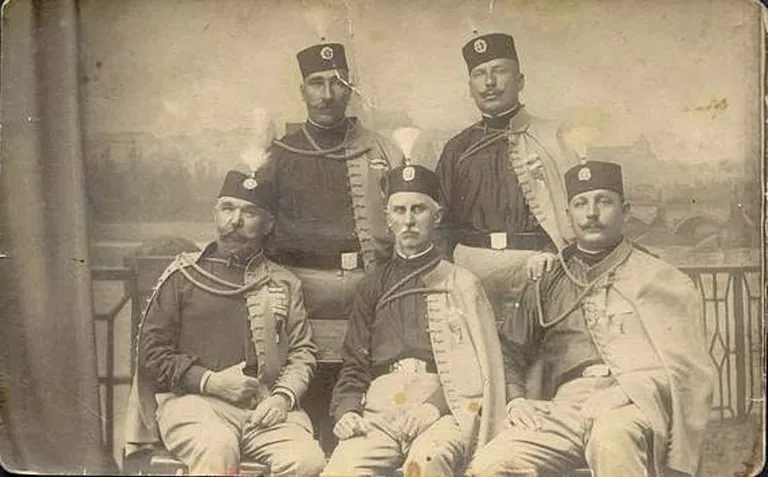Last updated on January 27th, 2023 at 11:03 pm
World War I had many causes, such as imperialism, militarism, nationalism, and defensive alliances. However, one event that was a shot in the arm for the war was the assassination of Archduke Franz Ferdinand in 1914 by the Serbian Black Hand.
Who was the Black Hand? What were their reasons for assassinating Franz Ferdinand? We answer these questions and give insight into some events that led to World War I.

Serbian Turmoil
In 1878, the crumbling Ottoman Empire and Serbian nationalism gave birth to an independent Serbian nation. Despite this development, many Serbs remained unsatisfied because they still lived in the Austro-Hungarian Empire.
The Serbs wanted to unite their territories and citizens into a state called “Greater Serbia.”
There was already unrest among the Serbian population because of Austrian oppression. In 1908, Austria-Hungary’s complete annexation of Bosnia-Herzegovina led to outrage among the Serbs.
On October 8, 1908, two days after Bosnia-Herzegovina’s annexation, many men, including high-ranking Serbian ministers, officials, and generals, convened at City Hall in Belgrade.
They founded the Narodna Odbrana (or National Defense), a semi-secret nationalist society. Its goal was to recruit and train partisans for a potential war between Serbia and Austria-Hungary.
Narodna Odbrana carried out anti-Austrian propaganda while sending spies and saboteurs to work within the seized regions of the empire. They formed satellite groups in Bosnia, Slovenia, Herzegovina, and Istria. The Bosnian satellite organization was called “Mlada Bosna” or “Young Bosnia.”
The Black Hand Rises
On May 9, 1911, 10 Narodna Odbrana formed the Black Hand — sometimes called “Unification or Death” (or Ujedinjenje ili Smrt in Serbian). The Black Hand was a secret Serbian nationalist group mostly comprised of the Serbian military. Colonel Dragutin Dimitrijevic or Apis headed it.

The group planned guerrilla acts and to assassinate targets from the Austro-Hungarian and Ottoman empires so that they would have the Greater Serbia they envisioned. They were dedicated to extending the Serbian state and re-establishing the former Serbian Empire.
Members of the Black Hand used to their advantage the key positions they held in the Serbian army and government, allowing them to influence government appointments and policies.
The Serbian government was aware of the Black Hand’s existence and kept itself in the loop of the group’s activities. However, friendly relations between them had cooled by 1914.
Mostly, the group was unhappy with Prime Minister Nikola Pasic. They thought he wasn’t working hard enough toward the Pan-Serb cause. In addition, there were many contentious issues, such as who would hold the Serbian territories regained in the Balkan Wars.
Motives for the Assassination
People called Austria-Hungary the “Dual Monarchy” because their respective monarchs ruled over separate territories within their kingdom. Each half had its government, parliament, and constitution and treated the citizens of the other half as foreigners.
The empire was home to many Slavic citizens, including Slovaks, Slovenes, Czechs, Croats, Ukrainians, and Poles. However, these citizens did not enjoy the same representation level as the German Austrians.
Archduke Franz-Ferdinand, heir apparent to the Austro-Hungarian Empire, was a staunch supporter of the Slavs. He wanted to give the Slavs greater autonomy and the opportunity to rule themselves.
However, the notion threatened the Serbian nationalist cause since it would effectively pull the plug on the rising Serbian Empire.
To thwart the potential threat, Apis decided to kill Franz Ferdinand in 1914.
The Assassination of Franz Ferdinand
To carry out the assassination, Apis recruited and trained three young Bosnian Serbs — Gavrilo Princip, Nedeljko Čabrinović, and Trifko Grabež — in marksmanship and bomb-throwing. They were transported across the Serbian border into Bosnia through a network of underground contacts where they would meet other conspirators recruited locally.
When the Black Hand and the Serbian government became aware of the assassination plot, they instructed Apis to forsake his plans. Apis feebly attempted to intercept the assassins at the border. However, they had already crossed.
This failed interception happened two weeks before the archduke’s visit to Bosnia. The three young assassins stayed in Sarajevo for about a month, during which neither Apis, the other Black Hand leaders, nor the Serbian government did anything to stop them.
They also neglected to use the extensive underground contacts that smuggled the assassins into Sarajevo to get word to them.
After a rocky start, on June 28, 1914, Gavrilo Princip assassinated Franz Ferdinand and his wife, Sophie, in Sarajevo.
The Black Hand carried out its assassination plot with utmost secrecy, which prevented most of the group from being identified as the perpetrator until weeks later. By then, the blame had loosely settled on Serbia, further increasing the political tension between Serbia and Austria-Hungary.
It led to a declaration of war from Austria-Hungary against Serbia and gradually got the other European powers involved. This escalated into the First World War.
The Trials
After the archduke’s assassination, the nearby crowd started to attack Gavrilo Princip, who was then directly captured. A trial was held in 1914 in Sarajevo, sentencing him to 20 years in prison. It was the maximum prison time he could get as he was under 20.
Princip never served his entire sentence because he contracted tuberculosis and died in 1918 at the Terezín fortress in Bohemia.
Meanwhile, by the end of 1916, Prime Minister Nikola Pasic declared that he would destroy the Black Hand leaders and disband the organization. In 1917, several leaders of the Black Hand, including Apis, were arrested.
In May 1917, a show trial was held before a military tribunal for Apis and the other leaders. One of the many charges laid on them was an attempt on Prince Regent Alexander’s life. They had many witnesses against them, but most of the evidence was hearsay or fabrication.
The tribunal sentenced Apis and six others to be executed. Three received commutations to lengthy prison sentences, while Apis and the three leaders were executed by firing squad on June 26, 1917.

